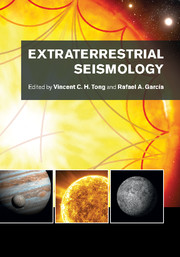Book contents
- Frontmatter
- Contents
- List of contributors
- Preface
- Acknowledgements
- List of abbreviations
- Planetary seismology: High risk, high return
- A bright outlook for helio- and asteroseismology
- Part I Observation and space missions
- Part II Data and physical parameters
- Part III Modeling approaches
- Part IV Discoveries of physical structures and processes
- Part V Interdisciplinary research involving planetary and astrophysical sciences
- Part VI Interdisciplinary research involving terrestrial seismology
- 24 The interpretation of seismic travel times
- 25 Interpreting cross-correlations in seismology
- 26 Waveform tomography in geophysics and helioseismology
- References
- Index
25 - Interpreting cross-correlations in seismology
from Part VI - Interdisciplinary research involving terrestrial seismology
Published online by Cambridge University Press: 05 July 2015
- Frontmatter
- Contents
- List of contributors
- Preface
- Acknowledgements
- List of abbreviations
- Planetary seismology: High risk, high return
- A bright outlook for helio- and asteroseismology
- Part I Observation and space missions
- Part II Data and physical parameters
- Part III Modeling approaches
- Part IV Discoveries of physical structures and processes
- Part V Interdisciplinary research involving planetary and astrophysical sciences
- Part VI Interdisciplinary research involving terrestrial seismology
- 24 The interpretation of seismic travel times
- 25 Interpreting cross-correlations in seismology
- 26 Waveform tomography in geophysics and helioseismology
- References
- Index
Summary
Introduction
Wavefields in the Sun and Earth, measured using various instruments, display small- amplitude fluctuations, essentially zero-mean random processes. More careful investigation reveals that these are seismic fluctuations generated by stochastic processes such as convection in the Sun and by anthropogenic activity and non-linear ocean wave interactions on Earth. The distinguishing feature of imaging with noise is that we do not know the dynamical details of the source (unlike in classical earthquake tomography) and we consequently seek a statistical description of the wavefield.
Here, we discuss the interpretation of the cross-correlation measurement in solar and terrestrial scenarios. The most common measurement in the context of noise is the ensemble- averaged cross-correlation. The physics of such measurements can be markedly different from raw wavefield measurements (as in classical tomography). The helioseismic theory of stochastic oscillations in conjunction with computational adjoint optimization, widely used in terrestrial seismic applications, provides a unified framework for addressing outstanding inverse problems in these areas. The seismic methodologies and challenges in each of these fields, despite the vastly different physics, are intimately related and we highlight these similarities in this article.
Seismology of the Sun
The Sun, our nearest star, serves as an astrophysical benchmark, contributing to our understanding of stellar evolution, stellar interiors and atmospheres, etc. Life on Earth is directly affected by the magnetic variability of the Sun. Our climate is sensitive to variations in the irradiance of the Sun caused by cyclic magnetic activity. Space instrumentation and telecommunications are susceptible to solar high-energy eruptive events (e.g., for reviews, see, Schrijver and Zwaan, 2000). Predictive models of solar magnetic activity (e.g., Pesnell, 2008) depend on our knowledge of internal global-scale fluid motions of the Sun, constraints that can only be obtained seismically.
Subsequent to the discovery of oscillations on the surface of the Sun some 50 years ago (Leighton et al., 1962), there has been significant progress in uncovering its properties.
- Type
- Chapter
- Information
- Extraterrestrial Seismology , pp. 353 - 364Publisher: Cambridge University PressPrint publication year: 2015



